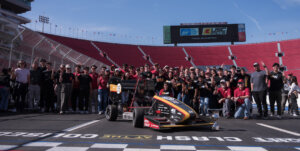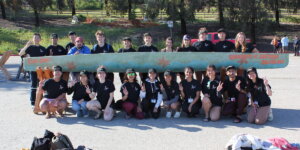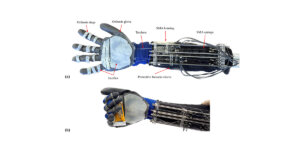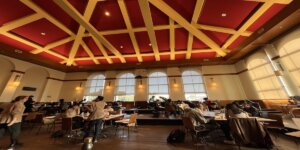
USC Recumbent Vehicle Design Team riding their tricycle around campus. From left to right: Neta Glaser, Phil Thoenen, Patrick Ortiz, Mary Bessell, James Gabbard and Alex Dulin. Photo/Noe Montes
Aboard their 40 pound, 6-foot-long tricycle, the USC Recumbent Vehicle Design Team was a tenacious competitor at the American Society of Mechanical Engineering’s North American West Human Powered Vehicle Challenge. Of the 17 teams at the competition, the USC team placed fourth overall, earning a first-place finish in the men’s speed event, a third-place finish in the women’s speed event and a third-place finish in the endurance event.
The event took place at the ASME E-Fest (Engineering Festival) on March 23-25 at the Fairplex in Pomona, California. The competition gives students an opportunity to demonstrate engineering design principles through the development of fast, efficient and durable vehicles for everyday use.
After a full day of safety inspections and report presentations, the racing events begin. These include the men’s and women’s speed events, which is a 250-meter drag race, as well as a 2.5-hour long endurance race where riders complete as many laps as they can. The endurance race is completed by multiple riders and includes obstacles such as a rumble strip made of planks of wood and several “pickup and deliveries” in which riders must carry a carton of eggs around the track.

USC RVDT Team at the 2018 Human Powered Vehicle Challenge in Pomona, CA From left to right: Neta Glaser, James Gabbard, Bennett Hazelgrove, Philip Thoenen and Clarice Pumerantz. Photo/Matthew Gilpin
“The biggest challenge during competition is on-the-fly repairs. The actual race and competition are straightforward, if the vehicle holds together. Two days of intense racing takes its toll and the team has to deal with issues quickly, yet carefully to keep riders safe and in the lead,” said Matthew Gilpin, a lecturer in the USC Viterbi Department of Aerospace and Mechanical Engineering and the team’s faculty adviser.
The results are in
During this year’s speed events, they had major issues with two components: the brackets supporting the rider’s seat were cracking and the steering column rod was bending. Luckily, they were able to find new parts and fix the damaged pieces between heats, resulting in a third-place finish by women’s speed rider Clarice Pumerantz and a first-place finish by men’s speed rider James Gabbard.
After spending the night machining more effective replacement parts at USC, the endurance event went off without a hitch. Though they broke some eggs, they were able to complete 30 laps, earning them third place.
“Our team did an amazing job,” Gilpin said. “I think the reason we did so well this year was learning from last year. Our senior riders had the experience of racing in 2017 and learned from what went wrong during competition. Based on that experience, we didn’t have any of those problems and built a much stronger vehicle for 2018.”
A short, but strong history
The USC Recumbent Vehicle Design Team, or RVDT, first entered the Human Powered Vehicle Challenge after forming in 2014. In their first year at the competition, they placed fifth. This year marks their return to the top five and their best performance to date.
While the team is small, comprised of five engineering board members and a handful of other students who participate throughout the year, the students, “have a lot more ownership and a lot more responsibility,” said Gilpin.
“Anybody with an idea that relates to pedal-powered racing can find space, resources and support to explore that idea,” said Gabbard, the team’s chief engineer and a senior mechanical engineering and applied mathematics student. “Having the freedom to pursue independent projects, make mistakes and learn from them has been absolutely invaluable, and that’s what I’ve enjoyed most about USC RVDT.”
Pumerantz, the team’s composites captain and mechanical engineering senior added, “We want everyone to feel like they are getting the most out of this club. Everyone who joins leaves with an understanding of what it takes to make a dream a reality.”
Published on April 9th, 2018
Last updated on April 8th, 2021











